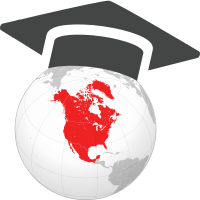North American Universities World Representation
How many colleges and universities are there in North America in 2024? According to the uniRank database, which selects only institutions offering at least four-year undergraduate degrees (bachelor's degrees) or postgraduate degrees (master's or doctoral degrees), there are currently 1,840 officially recognized higher-education institutions in North America. Considering that the uniRank database includes a total number of 14,013 officially recognized higher education institutions the proportion of North American Universities in the world is as follows:
-
uniRank North American Universities World Representation Index: 13.1%
Being the estimated population of the North American continent around 4,9% of the total world population (source: United Nations' World Population Prospects, the 2015 Revision), the North American Higher education system and offerings seem to be significantly overrepresented in the world at least in terms of the number of higher education institutions.
Public vs Private Universities in North America
How many public and private colleges and universities are there in North America in 2024? Out of the total number of 1,840 recognized higher education institutions in North America included in the uniRank database, 681 (37%) are public (i.e. officially affiliated to or run by national/federal, state or local governments) and 1,158 (62.9%) are private.
In terms of the number of public versus private Universities, the uniRank database shows a much higher presence of private higher education institutions in the North American area as a whole. However, 142 (71%) out of the top 200 Universities in North America are public higher education institutions. Differences and peculiarities may still exist in each North American country's higher education system.
Non-profit vs for-profit Universities in North America
What type of entities are Universities in North America in 2024? Out of the total number of 1,840 recognized higher education institutions in North America included in the uniRank database, 1,791 (97.3%) are non-profit and 48 (2.6%) are for-profit. As a general rule, the vast majority of North American public higher education institutions are not-for-profit organizations, not necessarily in legal terms but certainly in terms of nature and institutional purposes such as role, scope and mission.
Challenges for the higher education systems in North America
What are the main challenges that higher education in North America currently faces? According to uniRank the main issues of the higher education systems in North America are:
a) Access and affordability: access to higher education is still a challenge for many underrepresented and low-income students in North America. This can be due to financial barriers, inadequate preparation in primary and secondary schools or systemic biases that limit opportunities for marginalized groups. The cost of attending college or university in North America is a significant challenge for many students and their families. Rising tuition fees, housing costs and other expenses make higher education inaccessible for some students.
b) Student debt: many students in North America must take out loans to pay for their education, which can lead to high levels of debt upon graduation. This debt can limit graduates' ability to pursue their desired careers, start businesses or invest in their future.
c) Employability and relevance: some employers and policymakers argue that the higher education system in North America does not adequately prepare students for the workforce. They suggest that there is a mismatch between the skills and knowledge that students acquire in college or university and what employers need.
d) Technology: the increasing use of technology in higher education presents both opportunities and challenges. Institutions must invest in and adapt to new technologies to remain competitive, but they must also ensure that these technologies support student learning and engagement not at the expense of face-to-face teaching quality.
Addressing the above challenges will require collaboration between policymakers, higher education institutions, employers and other stakeholders in North America. Some potential solutions include increasing funding for financial aid programs, improving K-12 education, offering more support services for students and enhancing the alignment between higher education and workforce needs.
Top 200 Universities in North America
uniRank publishes twice a year a non-academic university ranking of the top 200 Universities in North America based on valid, unbiased and non-influenceable web metrics provided by independent web intelligence sources. Please read the ranking methodology on the About Us page for more information.

 Bermuda
Bermuda